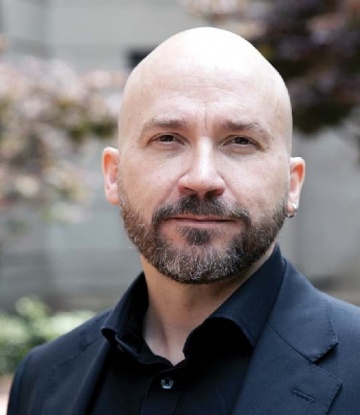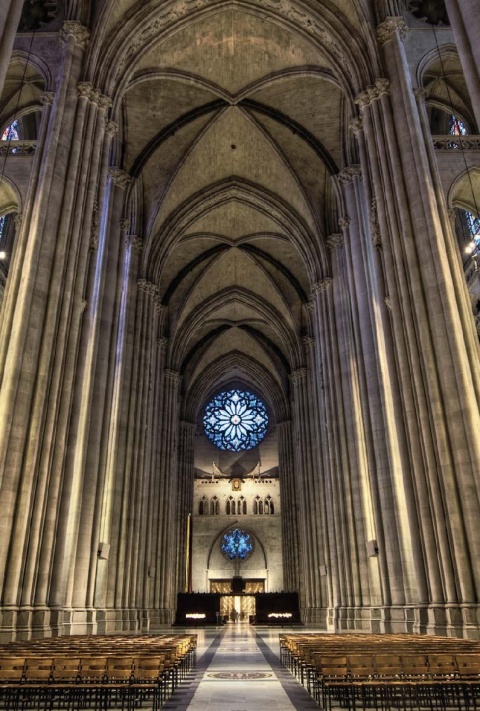Columbia College | Columbia University in the City of New York
The Core’s Cultural Programming
*CCT_Fall_2025_vFINAL1_Page_13_Image_0001.jpg

Core Curriculum director Larry Jackson
Emma Asher
It was my first experience of a decades-old Core Curriculum tradition: Collegium Musicum, one of Columbia’s choirs, was performing Josquin des Prez’s “Ave Maria,” a 15th-century motet (a type of vocal composition), for Music Humanities students. Each semester, the ensemble performs this piece for dozens of Music Hum sections in the stairwells of Hamilton and Dodge to evoke the acoustical resonance of a cathedral.
When we talk about the Core, we tend to picture students sitting around a table with books in hand. But one of the most crucial elements of the Core experience takes place outside the classroom. Each semester, thousands of students attend musical performances and visit museums with their Core classes.
Music Hum students venture to the Metropolitan Opera at Lincoln Center, where they encounter repertory works by Mozart, Verdi and Puccini, as well as contemporary operas by composers such as Terence Blanchard. They also engage with the works of living composers through Miller Theatre’s “Composer Portraits” series.
In Lit Hum, students visit the Metropolitan Museum of Art, where they view artifacts from the world of Homer; devotional art and sacred objects related to religious texts on the syllabus; and portraits from the 19th and 20th centuries that open windows into the worlds written about by Jane Austen, Virginia Woolf and Toni Morrison.
*CCT_Fall_2025_vFINAL1_Page_13_Image_0002.jpg

The Cathedral Church of St. John the Divine
In addition to these regular cultural outings, Core instructors often take their students to Broadway shows, art galleries and temporary museum exhibitions, such as the Morgan Library’s 2023 exhibition on Enheduanna, an ancient author read in Lit Hum.
The Core also sponsors special events on campus. Last fall, the Alkemie music ensemble performed works by Hildegard of Bingen in St. Paul’s Chapel, part of Columbia Religious Life’s interfaith Sacred Music program.
The diverse cocurricular activities that students participate in through the Core have four distinct educational benefits.
First, they bring to life the works encountered in the classroom, closing distances in both time and space. Students learn that culture is not an ossified relic of the past, but a living part of the present, as artists reinterpret older works and generate new ones that are in dialogue with their forebears. They don’t have to fly to Europe to see a cathedral; they can walk to one that’s just a few blocks away and experience the awe that comes from moving through its space.
Second, events outside the classroom build bridges between course syllabi, making the Core a more cohesive intellectual project. Lit Hum tours at the Met are led by Art Hum instructors. A 2024 exhibition on Muslim Spain at the Institute for the Study of the Ancient World enabled students to make connections between the Mosque-Cathedral at Cordoba, which is covered in Art Hum, and authors such as Ibn Arabi and Averroes, whose works are read in Lit Hum and Contemporary Civilization.
Third, these outings serve as a gateway to the city in which students will live for four years, giving them access to, and knowledge of, the vibrant cultural institutions that are the jewels of New York City.
Fourth, and most importantly, the Core’s co-curricular activities create community, giving students shared experiences that help make possible the kinds of discussions that we want them to have in the classroom. You are more likely to disagree respectfully with someone when you have experienced with them the beauty, emotion and fellowship that art, music and theater can inspire. For those who’ve never visited a museum or gone to an opera, Core outings foster a sense of belonging, and reinforce the idea that everyone has an equal claim to the works they study.
My encounter with the Core’s cultural programming on that busy morning — when the interlacing melodies of “Ave Maria” held me in thrall on the Hamilton stairs — held another important lesson that I hope all of our students learn: Beauty not only elevates us, but it also educates us. And it often awaits us where we least expect it.
Issue Contents
Published three times a year by Columbia College for alumni, students, faculty, parents and friends.
Columbia Alumni Center
622 W. 113th St., MC 4530, 6th Fl.
New York, NY 10025
212-851-7852
cct@columbia.edu
Columbia Alumni Center
622 W. 113th St., MC 4530, 4th Fl.
New York, NY 10025
212-851-7488
ccalumni@columbia.edu

